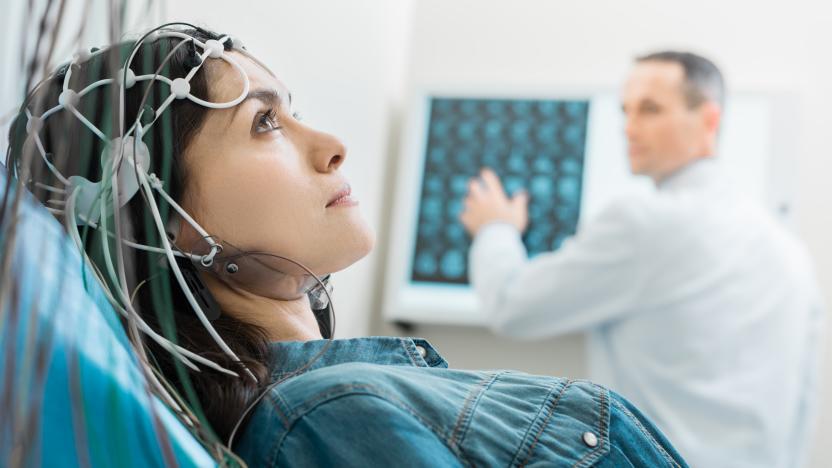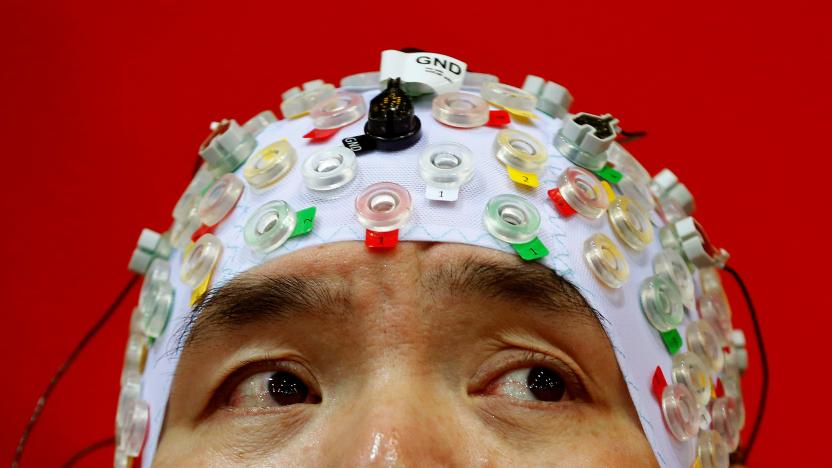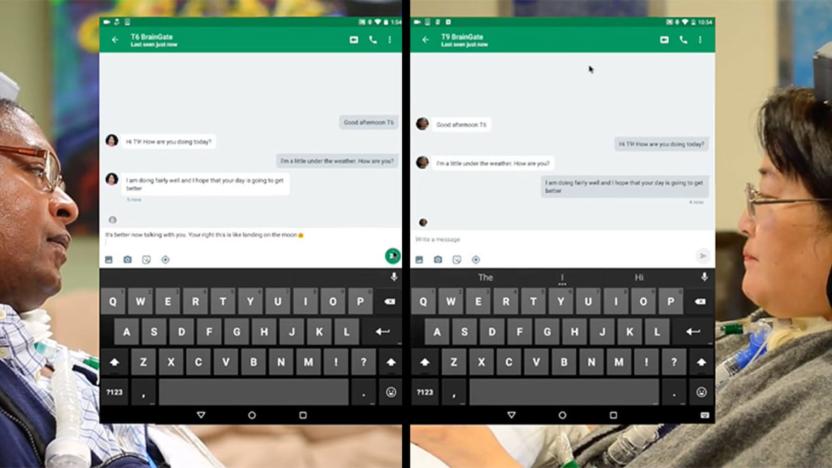neurology
Latest

Hitting the Books: Who's excited to have their brainwaves scanned as a personal ID?
In her new book, The Battle for Your Brain, Duke University Professor of Law, Nita A. Farahany, examines the legal, ethical, and moral threats that tomorrow's mind-monitoring neurotechnologies could pose.

What Neuralink and other BCIs can and can't do
Elon Musk's BCI startup wants to make people more than human by putting computers in their heads but a number of neurology researchers aren’t quite so bullish on these fantastical promises.

Hitting the Books: These brain cells could hold clues to the CTBI crisis
Welcome to Hitting the Books. With less than one in five Americans reading just for fun these days, we've done the hard work for you by scouring the internet for the most interesting, thought provoking books on science and technology we can find and delivering an easily digestible nugget of their stories.

Implant turns brain signals into synthesized speech
People with neurological conditions who lose the ability to speak can still send the brain signals used for speech (such as the lips, jaw and larynx), and UCSF researchers might just use that knowledge to bring voices back. They've crafted a brain machine interface that can turn those brain signals into mostly recognizable speech. Instead of trying to read thoughts, the machine learning technology picks up on individual nerve commands and translates those to a virtual vocal tract that approximates the intended output.

Researchers partially revive pig brains four hours after 'death'
Used to be that once someone cut off your head, your life was over. That may no longer be the case. A study published in the journal Nature this week illustrates Yale researchers' successful efforts to restore and preserve the cellular function of pig brains up to four hours after their decapitation at a local slaughterhouse. Miracle Max, eat your heart out.

Brain implant lets paralyzed people turn thoughts into text
Three people paralyzed from the neck down have been able to use unmodified computer tablets to text friends, browse the internet and stream music, thanks to an electrode array system called BrainGate2. The findings could have a major impact on the lives of those affected by neurologic disease, injury, or limb loss.

LED implants could ease your pain
One day, eliminating pain may just be a matter of flicking on a light. Scientists have shown that you can implant LEDs that stop neurons from firing and cut out pain reception. The current technique (tested in mice) requires altering the neurons' DNA -- you couldn't just stick them in anyone. They're soft, however, and safe enough that you can leave them under the skin for long periods of time without limiting motion or wrecking tissue.

Doctor dubbed 'the father of cyborgs' tested implants in his own brain
How far would you go to create a brain-controlled speech decoder? Doctor Philip Kennedy already helped blaze a trail in brain-computer interfaces back in the 80s. Now, a report in MIT Technology Review explains how the neurosurgeon decided to crank his research up a notch. Well, several notches, really, by having implants put into his own brain to better learn how neurons function with speech. What's more, Kennedy paid $25,000 and underwent highly invasive surgery -- including the removal of the top of his skull -- for the privilege.

Doctors find a way to deliver drugs straight to your brain
The blood-brain barrier (BBB) is a marvelous piece of evolutionary engineering designed to keep the inside of your skull pristinely clean by segregating the nervous and circulatory systems. The downside to this nearly impermeable membrane is that it is as adept at blocking therapeutic molecules as it is against harmful chemicals and microbes. However, a team from Canada's National Research Council (NRC) believe they've finally found the key that unlocks the body's Fort Knox. They're called "single domain antibodies" (SDA) -- molecular fragments capable of binding to larger molecules -- and they reportedly trick the BBB into thinking that most any molecule they're attached to is copacetic. So instead of having to wrap disease fighting medicines in carrier molecules like microscopic Trojan Horses, as has been the preferred method for the past two decades, these single domain antibodies act more like molecular security badges instead.

Rat brains are basically wired up like miniature internets
Drawing on forty years of peer-reviewed research, a team of researchers from the University of Southern California have generated the world's first "wiring diagram" of a rat's central nervous system. And, as it turns out, their brain structures are uncannily similar to the internet's physical architecture. What's more, this could help us better understanding of our own neural organization. "The cerebral cortex is like a mini-Internet," USC professor and corresponding author of the study Larry Swanson said in a statement. "The Internet has countless local area networks that then connect with larger, regional networks and ultimately with the backbone of the Internet. The brain operates in a similar way."

MIT can map the activity of every neuron in an animal's brain
Scientists have long yearned for a neuron-by-neuron illustration of brain activity; get that and you can see exactly what drives an animal's thoughts and reflexes. MIT may make those wishes come true, as it just revealed a system that produces a complete 3D neural activity map. The discovery revolves around a light field microscope (which refracts light to create a 3D image) that's optimized for looking at the electrical pulses of each neuron, right down to the millisecond time level. So far, researchers have created videos showing what's happening within the entire nervous system of a c. elegans worm, and the brain of a zebrafish larva.

Mind-operated robot arm helps paralyzed woman have her cup o' joe (video)
Researchers at the Braingate2 consortium have made a breakthrough that allows people with spinal cord or stroke injuries to control robotic limbs with their minds. The original project allowed subjects with motor cortex-implanted chips to move cursors on a screen with their minds, but they can now command DEKA and DLR mechanical arms to grasp foam balls and sip coffee. Researchers noted that dropped objects and missed drinks were frequent, but improved brain sensors and more practice by subjects should help. To see the power of the mind move perhaps not mountains, but good ol' java, jump to the video below.

FCC grants radio spectrum to muscle-stimulating wireless devices for paralysis patients
The medical community is all smiles today, because the FCC has decided to allocate a chunk of radio spectrum for potentially life-altering wireless devices. Designed for stroke patients and those suffering from brain or spinal cord injuries, these so-called medical micropower networks (MMN) use a set of implanted electrodes and a wearable wireless controller to stimulate the muscles of a paralyzed user. In a statement issued last week, the FCC announced that these devices have been approved for use within the 413 to 457MHz range, as requested in a petition from the Alfred Mann Foundation, which has already constructed several prototype MMN systems. The organization's CEO, David Hankin, immediately lauded the ruling, adding that the Foundation now plans to launch trials of MMN systems on humans, in the hopes of receiving clearance from the FDA. "The FCC's decision removes the most significant roadblock to helping people," Hankin said. "The frequency that has been approved for use is the most efficient for penetrating tissue with radio waves and without which the new generation of our implantable neurostimulator technology would be impossible to advance." The significance of the occasion wasn't lost on FCC chairman Julius Genachowski, either. "These broadband-enabled technologies are life-changing, impacting individuals, families, and communities in ways we can only begin to imagine," Genachowski said in a prepared statement. His sentiments were echoed in remarks from fellow commissioner Mignon Clyburn, who heralded the decision as "one of the most important the commission has adopted during my tenure," citing its potential to "greatly improve the lives of those who are faced with some of today's most difficult medical challenges."

Monkeys control virtual arm with their brains, may herald breakthrough for paraplegics
Monkey mind-controlled arm: It sounds like the name of an awesomely terrible sci-fi film or a fledgling grindcore group, but it's a very real phenomenon, and one that could pay significant dividends for paraplegics everywhere. Neurobiology professor Miguel Nicolelis and his team of researchers at Duke University recently devised a method by which monkeys (and, perhaps one day, humans) can control a virtual arm using only their brains. It's a concept similar to what DARPA has been pursuing with its mind-controlled "Luke" arm, with one important difference: Nicolelis' system not only allows users to remotely execute motor functions, but provides them with near-instantaneous sensory feedback, as well. Most similar techniques use electrode implants to stimulate brain activity, but this can create confusion when a patient's brain sends and receives signals to and from a prosthetic arm. Nicolelis circumvented this problem with a new interface that can read and transmit brain signals to an artificial limb, before switching to a receptive mode in just milliseconds. After designing the technology, Nicolelis and his colleagues tested it on two, electrode-equipped rhesus monkeys. One set of electrodes was placed in the motor cortex of each animal, with the other implanted within their brains' sensory regions. They then trained the monkeys to look at a three identical objects on a computer screen and to "touch" each object with a virtual arm, controlled by signals sent from the brain electrodes. Only one of the three objects had a so-called "virtual texture," which, if selected with the on-screen arm, would send a sensory signal back to the monkey's brain (while triggering a tasty squirt of fruit juice for the lucky contestant). The two rhesus species ended up passing the test with flying colors, resulting in a "proof of principle" that Nicolelis' system can send tactile signals to the brain in almost real-time. The scientists have already developed a way for monkeys to control the arm wirelessly, and are now embedding their technology within a full-body, mind-controlled exoskeleton for paralyzed patients, as well. Of course, the technology still needs to be tested on actual humans, though Nicolelis seems confident that he and his team have already cleared the most difficult hurdle: "Since we cannot talk to the monkeys, I assume with human patients, it's going to be much easier."

KDDI's mind-reading Android app monitors your brainstorms, or lack thereof... (video)
Ready for an epic brainwave dance-off between Jobs' Jets and Rubin's Sharks? Well, put down your shivs and get back to that alpha state because it's gonna take a little while. Developed by KDDI's R&D labs, this prototype mind-monitoring, sensor-laden headband connects wirelessly to your Android device to let you know just how stressed out you are. All it takes is a simple 30-second game of "mash mash mash the little green robot" (amongst others) to translate your focused and relaxed states into an easily readable brain pattern chart. The tech's nothing we haven't already seen the ominously named NeuroSky do for the iOS platform, but it should help to get those fanboy flames a-blazing. Of course, if mobile OS turf wars don't get your neurons in a tizzy, you could always spend half a minute thinking of your honey -- or actual honey. Whatever floats your neural boat. Video demonstration after the break.

Scientific study shows internet use changes human memory
The internet has fundamentally affected the way people access and store information, and many people (myself included) have wondered if it's also changing the way our minds work. According to the New York Times, a recently published scientific paper shows that we are indeed changing the way we store information in our brains thanks to the internet. The paper's title, "Google Effects on Memory: Cognitive Consequences of Having Information at Our Fingertips" sounds faintly ominous, and the study results do show that people are less likely to retain information if they believe they'll simply be able to Google it later. According to the study's abstract, "When people expect to have future access to information, they have lower rates of recall of the information itself and enhanced recall instead for where to access it." The implication here seems to be that instead of dumbing us all down and turning our memories into sieves, we're becoming less reliant on our own memories and more capable of turning to external sources for finding information. Before the internet, finding an esoteric bit of data usually meant a trip to a library or other physical storehouse and a laborious search, which made retaining that data in one's own memory more important; now, that same data is accessible within seconds if you've got a decent 3G connection. In a sense, we've offloaded a portion of our own memory into the "cloud." The Star Trek geek in me has to point out that these handheld boxes we use to access a huge storehouse of information, supplementing our comparatively limited "wetware" memories, is similar in many ways to the Bynars from the first season of The Next Generation. Those fictional aliens were reliant on their equivalent of the internet to a vulnerable extent, however; without their central computer, they'd be unable to survive. We haven't reached that point quite yet, but as Google and related online services supplement human memory more and more, trivia demigods like Ken Jennings may become increasingly rare in future generations.

Toyota Prius Project's concept bike lets you shift gears with your mind
Got mind control on the mind? Check out this new concept bike from Deeplocal -- a Pittsburgh-based design house that's adding a neurological twist to the art of cycling. As part of Toyota Prius Project No. 11, the company outfitted the seat post of a Parlee PXP aero road bike with a wireless transmitter, allowing users to remotely shift gears with a smartphone. Deeplocal's designers then added a set of neuron transmitters to a helmet and re-programmed the PXP to communicate with them -- meaning, in theory, that riders could control the bike's gears by simply thinking about it. Theory, of course, isn't the same thing as practice, but perhaps the concept will become a reality if we think really hard about it.

Somnus Sleep Shirt watches while you sleep, won't be creepy about it (video)
Monitoring sleep patterns usually involves a hydra of sensors that keep track of brain activity, muscle movements and heart rates, but a startup called Nyx Devices has developed a new night shirt that can evaluate the quality of a user's slumber by analyzing only breathing patterns. The form-fitting Somnus Sleep Shirt is embedded with two sensors that keep track of a person's overnight breathing and transmit this information to a small data recorder, which slides into the lower corner of the nightie. When a user wakes up, he or she can upload their stats to Nyx's website, where they can generate more detailed analytics and log their caffeine and alcohol intake to find out how all those martini lunches affect their snoozing. Co-inventor Matt Bianchi, a sleep neurologist at Massachusetts General Hospital, thinks the Somnus could help patients suffering from insomnia, who often have difficulty determining how much shuteye they actually get. It's worth noting, though, that this exclusively respiratory approach is still considered experimental and Nyx still has to conduct a few at-home tests before bringing the shirt to market next year, hopefully for less than $100. Until then, we'll just keep tossing and turning in our Spider Man jammies. Stroll past the break for an appropriately soporific video.

Startup's headset will bathe your brain in ultrasound, might help fight cancer, too
The scientific community has spent a decade exploring ultrasound as a means of breaking through the blood-brain barrier -- a layer of tightly-packed cells that surround the brain's blood vessels, making it difficult for doctors to deliver chemotherapy and other treatments to cancer patients. Thus far, though, most ultrasound-based techniques have relied upon complex and often costly equipment, including MRI machines and infusion pumps. But researchers at a startup called Perfusion Technology think they may have come up with a less invasive, more cost-effective alternative -- a new headset designed to deliver low-intensity ultrasound therapy to the entire brain over the course of extended treatment periods. This approach differs markedly from most other methods, which typically target smaller areas of the brain with high-intensity ultrasound doses. As with most other potential breakthroughs, however, Perfusion's technique still needs to undergo some major testing. The company has already conducted several tests on animals, but the last time a similar method was tried on humans, many subjects ended up suffering from excessive bleeding. And that doesn't sound good at all.

Portable brain tumor treatment system kills cancer while you take out the trash
We've seen robots that perform brain surgery and lasers that cook tumors, and now a team of researchers are well on their way to bringing mobility to the battle against brain cancer. The NovoTTF-100A, which just received FDA approval, is basically a set of insulated electrodes, attached to an electronic box, that pumps low intensity electrical fields to the site of a freshly diagnosed GBM (glioblastoma multiforme) tumor. The fields, known as Tumor Treatment Fields (TTF), play off the electrically charged elements of cancer cells to stunt the tumor's growth, and may in some cases actually reverse it. A recent test of the system showed comparable results to chemotherapy, without the usual lineup of side effects, including nausea, anemia, fatigue, and infection. Given, patients using the system are expected to wear the thing continuously, but we'd say walking around with a cap full of electrodes is a small price to pay for giving cancer the boot. Full PR after the break.








